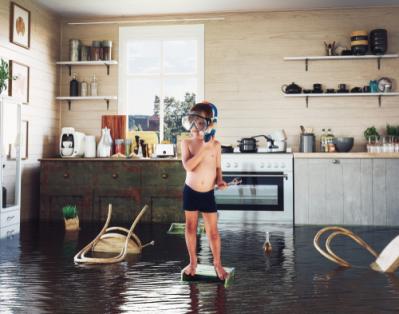It’s no secret that sea levels are rising, leaving millions of homes at risk globally and according to a recent report, over 200,000 homeowners in England may have to relocate by 2050.
Similarly, a climate action group has predicted that over 2,000 properties worth over half a billion pounds are at risk of being destroyed due to coastal erosion by 2100.
While many might think summer spells the end of flooding season, the reality could be quite the contrary. Some experts predict periods of unusually hot weather and consequential droughts will make the ground less permeable, increasing the risk of flooding from surface water.
What is a high-risk flood area?
Due to rising sea levels destroying sea defences, people living in coastal areas like Cornwall, Dorset, Devon, Kent and Sussex may be at a higher risk of flooding.
Similarly, houses near rivers are particularly vulnerable when there's significant rainfall or the river bursts its banks.
Additionally, excess rainfall can cause flooding - when the drains can’t take the volume of water. This is most problematic for homes built on floodplains, such as areas of Buckinghamshire, Yorkshire and Wiltshire.
The long-term flood risk is measured by a four-level classification: high risk (over 3.3%), medium risk (1-3.3%), low risk (0.1-1%) and very low risk (under 0.1%).
You can check your area’s long-term flood risk on the government website.
Can where you live affect your chances of getting home insurance?
Despite a growing number of homes now vulnerable to flooding, you may find that home insurance premiums are higher if you live in a high flood-risk area. This was certainly the case for 15 percent of survey respondents in 2021, who found that living within 400ft of water increased their premiums by an average of £28.
However, thanks to a government-backed scheme called Flood Re, many insurers like Homeprotect can now provide affordable home insurance to people in high-risk areas.
And while many buildings and contents insurance policies provide flood insurance (a type of buildings insurance) to cover your home and its contents against costs incurred by water damage from flooding, there will often be some requirements and limitations.
For example, insurers may require you to flood-proof your home if you live in a high-risk area and your policy may not cover things like fences or gates. Plus, if you live in a commercial property, a home built from 1 January 2009 or a block of more than three leasehold residential flats, you won’t be covered by Flood Re.
What are your rights to claim?
As a homeowner, you should check your insurance policy and report any water damage caused by floods to your insurance provider at your earliest convenience.
Your insurance provider should be able to inform you how long it will take a loss adjuster to survey the damage and if your policy covers professional help in cleaning up or redecorating.
Once your home is safe to re-enter, you must record any damage through photos, marking where the water level was at its highest and make a list of damaged items.
How can I mitigate the damage caused by flooding?
In the event of a flood, minimising the potential for damage shows your insurance provider that you’ve taken preventative measures and could work in your favour when making a claim.
Here are some top tips to consider before a flood:
- Immediately before a flood you can seal your windows, doors and air vents using sandbags or a barrier of some sort – be sure to remove these once the danger has passed
- Install a sump and pump system to remove water from ground level before it rises
- Install non-return valves to pipes and toilets to stop sewage backup
- Use water-resilient paints and plasters
In the event of flooding:
- Turn off electricity, water and gas supplies
- Wherever possible raise your furniture and household appliances such as washing machines off the floor using bricks or pallets
- Move any valuable items upstairs or away from the property
ENDS












.png)


.png)



Join the conversation
Be the first to comment (please use the comment box below)
Please login to comment